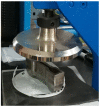Recycled Porcine Bone Powder as Filler in Thermoplastic Composite Materials Enriched with Chitosan for a Bone Scaffold Application
- PMID: 34451290
- PMCID: PMC8402051
- DOI: 10.3390/polym13162751
Recycled Porcine Bone Powder as Filler in Thermoplastic Composite Materials Enriched with Chitosan for a Bone Scaffold Application
Abstract
This work aims to synthesize biocompatible composite materials loaded with recycled porcine bone powder (BP) to fabricate scaffolds for in-situ reconstruction of bone structures. Polylactic acid (PLA) and poly(ε-caprolactone) (PCL) were tested as matrices in percentages from 40 wt% to 80 wt%. Chitosan (CS) was selected for its antibacterial properties, in the amount from 5 wt% to 15 wt%, and BP from 20 wt% to 50 wt% as active filler to promote osseointegration. In this preliminary investigation, samples have been produced by solvent casting to introduce the highest possible percentage of fillers. PCL has been chosen as a matrix due to its greater ability to incorporate fillers, ensuring their adequate dispersion and lower working temperatures compared to PLA. Tensile tests demonstrated strength properties (6-10 MPa) suitable for hard tissue engineering applications. Based on the different findings (integration of PLA in the composite system, improvements in CS adhesion and mechanical properties), the authors supposed an optimization of the synthesis process, focused on the possible implementation of the electrospinning technique to develop PCL-BP composites reinforced with PLA-CS microfibers. Finally, biological tests were conducted to evaluate the antibacterial activity of CS, demonstrating the applicability of the materials for the biomedical field.
Keywords: PCL; PLA; antibacterial activity; bone scaffold; chitosan; mechanical properties; recycled bone powder; thermoplastic composites.
Conflict of interest statement
The authors declare no conflict of interest.
Figures














Similar articles
-
Shish-kebab-structured poly(ε-caprolactone) nanofibers hierarchically decorated with chitosan-poly(ε-caprolactone) copolymers for bone tissue engineering.ACS Appl Mater Interfaces. 2015 Apr 1;7(12):6955-65. doi: 10.1021/acsami.5b00900. Epub 2015 Mar 23. ACS Appl Mater Interfaces. 2015. PMID: 25761418
-
A compound scaffold with uniform longitudinally oriented guidance cues and a porous sheath promotes peripheral nerve regeneration in vivo.Acta Biomater. 2018 Mar 1;68:223-236. doi: 10.1016/j.actbio.2017.12.010. Epub 2017 Dec 20. Acta Biomater. 2018. PMID: 29274478
-
Preparation and characterization of PLA/PCL/HA composite scaffolds using indirect 3D printing for bone tissue engineering.Mater Sci Eng C Mater Biol Appl. 2019 Nov;104:109960. doi: 10.1016/j.msec.2019.109960. Epub 2019 Jul 6. Mater Sci Eng C Mater Biol Appl. 2019. PMID: 31500051
-
[Mechanical properties of polylactic acid/beta-tricalcium phosphate composite scaffold with double channels based on three-dimensional printing technique].Zhongguo Xiu Fu Chong Jian Wai Ke Za Zhi. 2014 Mar;28(3):309-13. Zhongguo Xiu Fu Chong Jian Wai Ke Za Zhi. 2014. PMID: 24844010 Chinese.
-
Bioabsorbable Composites Based on Polymeric Matrix (PLA and PCL) Reinforced with Magnesium (Mg) for Use in Bone Regeneration Therapy: Physicochemical Properties and Biological Evaluation.Polymers (Basel). 2023 Dec 11;15(24):4667. doi: 10.3390/polym15244667. Polymers (Basel). 2023. PMID: 38139919 Free PMC article. Review.
Cited by
-
Scaffold Fabrication Techniques of Biomaterials for Bone Tissue Engineering: A Critical Review.Bioengineering (Basel). 2022 Nov 24;9(12):728. doi: 10.3390/bioengineering9120728. Bioengineering (Basel). 2022. PMID: 36550933 Free PMC article. Review.
References
-
- Di Bello C. Biomateriali Introduzione allo Studio dei Materiali per uso Biomedico. 1st ed. Patron; Bologna, Italy: 2004.
-
- Rahmati M., Mills D.K., Urbanska A.M., Saeb M., Venugopal J.R., Ramakrishna S., Mozafari M. Electrospinning for tissue engineering applications. Prog. Mater. Sci. 2020:100721. doi: 10.1016/j.pmatsci.2020.100721. - DOI
-
- Zhao P., Gu H., Mi H., Rao C., Fu J., Turng L.S. Fabrication of scaffolds in tissue engineering: A review. Front. Mech. Eng. 2018;13:107–119. doi: 10.1007/s11465-018-0496-8. - DOI
LinkOut - more resources
Full Text Sources

